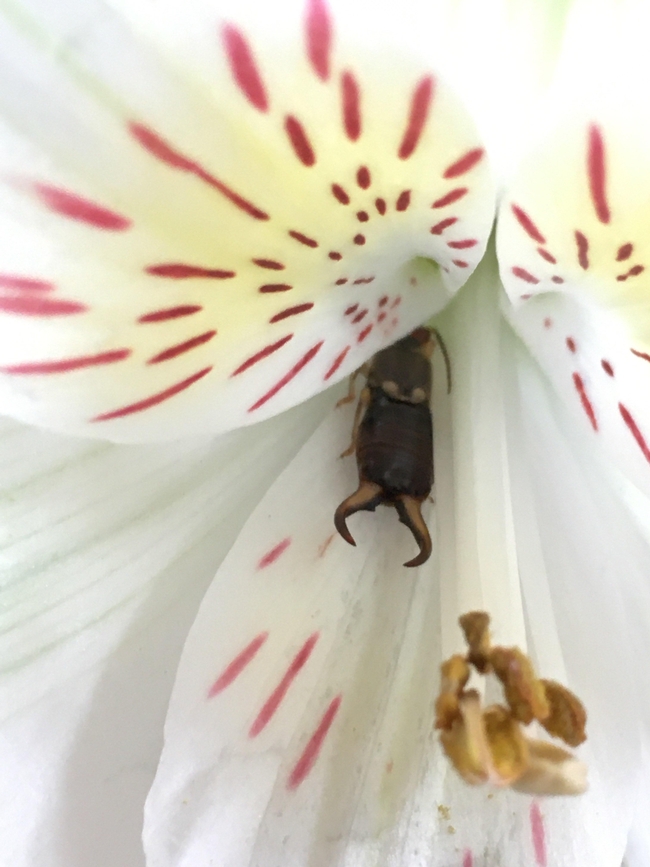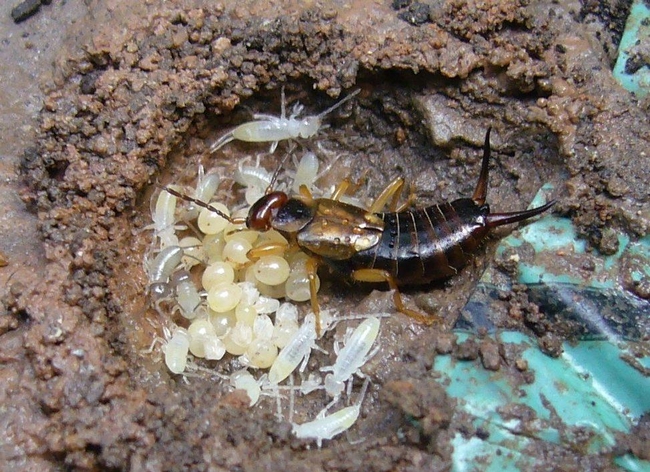
For most people, there is something cringe-worthy about the ubiquitous earwig. The name comes from Old English, ?ar-wicga derived from ?ar (ear) and wicga (beetle, worm, insect) and originated from the widespread false belief that the earwig crept into peoples' ears at night and burrowed into their brains. Earwig also means “a person who worms himself or herself into another's favour by whispering and insinuation; a person who seeks to influence others in secret,” “to importune or pester, esp. in private, to influence or bias (a person) secretly; to insinuate oneself into the confidence of (a person),” “to listen covertly to another person's conversation, to eavesdrop” or “to fill the head of (a person) with wild or eccentric notions.”1 Rather a lot of symbolism for a small brown insect—think Finnegans Wake or Wrath of Khan.
Despite the cringe-factor, earwigs occupy an equivocal place in our pest bestiary. While they can and do ravage vegetable seedlings, mow through annuals, infest budding flowers, and inflict significant damage on soft fruits and corn, earwigs also play a beneficial role by feasting on decomposing vegetation and pests like mites, aphids and other soft-bodied insects.2,3
The species of earwig found in our gardens is likely the European earwig, Forficula auricularia, which was introduced accidently around 1900. These earwigs commonly damage seedling, soft fruit, and sweet corn. Diagnosing European earwig damage is a process of exclusion. Seedlings may be missing all or parts of theirs leaves or even chewed down to the soil line, stem, and all. Leaves on older plants are often riddled with irregular holes and gnawed at the margins and edges. European earwig damage may look like the work of caterpillars, but earwigs do not leave frass (excrement) webbing or pupae, unlike caterpillars. It resembles the work of slugs, but there is no telltale slime trail. To confirm your diagnosis, go into the garden at night with a flashlight or headlamp and you can see your pest in action.
European earwigs (nymphs and adults) may gouge holes or tunnels into soft fruits, such as strawberries, raspberries, blackberries, apricots, and peaches. These holes can be shallow or extend deep into the fruit. In developing corn, earwigs eat the silks (pollen tubules), which prevents pollination. They also munch on flower buds and flowers. They are versatile and flexible in their diets, and I've found them in everything from artichokes to zinnias.2,4 Sometimes they are chewing away on the plants, other times they appear to be sheltering and probably other times they are busy eating aphids and other pests. Although I have never witnessed the pest control firsthand, Robert Orpet, PhD has shown that aphids were consumed in apple orchards even when the aphids were rare suggesting that European earwigs may provide biological control. He found no evidence of earwig damage to the fruit.5
If your garden is populated largely by lawn, trees, woody ornamental plants or an apple orchard, earwigs are unlikely to give you trouble and may provide benefits.6
If you are growing vegetables, herbaceous flowering plants, sweet corn, or plants with soft fruits such as strawberries and apricots and suspect that earwigs are causing damage, here are some things you can do.
Reduce outdoor hiding places by eliminating dense undergrowth around your plants, remove debris, from planting areas, store flowerpots, garden decorations and other structures that can provide refuge for earwigs, check your mulches to see if earwigs are hidden in them and remove them if necessary.
Trap earwigs using rolled newspapers, short lengths of bamboo or hose on the soil near plants at dusk. In the morning, pick up these items and tip the earwigs into a container of soapy water. People have also recommended using an empty low-sided tuna or cat food can with oil to trap earwigs—I have tried this but have only attracted cats, possums, and racoons so far. Other gardeners I have spoken to up here on the North Coast, like veteran Master Gardener Grant Eberly, have not found this effective either. You might have better luck. Earwigs are most active at night, and usually congregate in cool, dark moist places during the day. You can earwigs to your nightly pest patrol and let them join the slugs you pick off your plants in a pot of soapy water. You can also reduce the surface moisture in your garden by using drip irrigation. All these steps will help reduce earwig populations to more manageable levels.
Before we leave earwigs, I want to argue that they are more interesting than awful. First, unusual among insects it is easy to distinguish males and female—males have curved forceps-like appendages (technically known as cerci) and females are straighter. They use these appendages primarily in their rather involved courtship (!) and in defense.

SOURCES
- Oxford dictionary of English. (Oxford University Press, 2010).
- Flint, M. L. & Fayard, M. L. Earwigs Management Guidelines--UC IPM. (University of California Cooperative Extension, 2012).
- Flint, M. L. Pests of the garden and small farm: a grower's guide to using less pesticide. (University of California, Agriculture and Natural Resources, 2018).
- Coates, W. W. et al. European Earwig: Apricot Agriculture: Pest Management Guidelines UC Statewide IPM Program (UC IPM). UC IPM Pest Management Guidelines: Apricot https://www2.ipm.ucanr.edu/agriculture/apricot/European-earwig/ (2014).
- Orpet, R. J., Goldberger, J. R., Crowder, D. W. & Jones, V. P. Field evidence and grower perceptions on the roles of an omnivore, European earwig, in apple orchards. Biol. Control 132, 189–198 (2019).
- Earwigs--Quick Tips. Quick Tips http://ipm.ucanr.edu/QT/earwigscard.html (2019).
- Boos, S., Meunier, J., Pichon, S. & Kölliker, M. Maternal care provides antifungal protection to eggs in the European earwig. Behav. Ecol. 25, 754–761 (2014).
- Thesing, J., Kramer, J., Koch, L. K. & Meunier, J. Short-term benefits, but transgenerational costs of maternal loss in an insect with facultative maternal care. Proc. R. Soc. B Biol. Sci. 282, 20151617 (2015).
Image Male earwig in flower—photograph by Keyt Fischer, permission to use granted
Image Earwig maternal care photo source: https://commons.wikimedia.org/wiki/File:Nesting_Earwig_Chester_UK_2.jpg Citation: A nesting earwig. © Nabokov / Wikimedia Commons